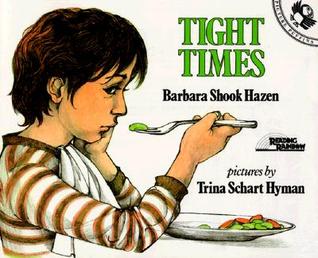
itle: Tight Times
Author: Barbara Shook Hazen
Illustrator: Trina Schart Hyman
Publisher: The Viking Press (1979)
Pages: 30 pages (16 w/ text)
Genre: Realistic Fiction
The story follows a family from the perspective of the young child of the family. The family is implicitly a low-income family that is struggling to make ends meet. This makes it difficult when the child keeps asking to get a pet dog. “Times are tight,” the dad explains to the child and this explains why the family doesn’t have all the things the child prefers. One day when the father returns home in the middle of the day after losing his job, upon the mother getting home when a “grown-up” talk ensues, the child is told to stay outside for a while, but not to go near the street. Outside, the child hears a strange crying sound: it’s an orphaned cat. After a passer-by, helps the child get the cat out of a trash can, she informs the child that they can keep the cat. After the parents discover the new friend, they let the child keep the cat. The child, agreeing not to ask for a dog anymore in exchange for being allowed to keep the cat , happily names the cat ‘dog’ and the child gets the “dog” they wanted after all.
Firstly, it actually took me a moment to realize my bias on this observation, but the child in the story is never referred to by gendered pronouns. Additionally, the child is androgynous, so there’s nothing to exclude any gender group in the character’s representation.
The story begins with the child requesting of the mother to get a dog. The room, along with all the rooms of the home, looks well furnished, but not cluttered. However, it is the actions of the mother, for example, on this first page that describe their financial situation as she hand stitches the buttons on a shirt, or coat. The mother denies the child’s request, she is too busy. So the child asks the dad, explaining that he promised them that when they were bigger the family could get a dog. The dad explains that it’s because of tight times, and that the child wouldn’t understand. However, as they go through their morning routine, the dad gives the child several examples to try and explain. Along these pages that father says tight times are why we have this instead of that, and the child likes that better. A nice thing about this sequence is that although the father’s words disparage the child’s ability to understand, he tries to make it understandable for the child in a different way, he’s trying to be honest and in doing so doesn’t belittle or condescend the child. Moreover, the child never says anything to the effect of “I need that,” but rather “I prefer that” showing that the child does on some level view “nicer” things as not a necessity, but a luxury. Simultaneously, this language does a nice job showing how the family’s financial situation is disparaged from a more financially-well off family, but does not demean the family itself.
Tight times are also why Mrs. McIntosh picks up the child from school and not the mother, because she has to work. Although a minute scene, the child and Mrs. McIntosh are at the bus stop with a diverse group of people, a group of people that you’d realistically expect to see at a city bus stop, and there’s a fun situation where all the dogs are attending to the child. This page is just a testament to the illustrator’s cognizance of the setting and people, and is worth noting.
Following that, father comes home early in the middle of the day. Mrs McIntosh is relieved of baby-sitting duty and he fixes himself and the child “special drinks”. The father is clearly somber in this image, drinking what is clearly liquor, but the child is oblivious to direness of the situation and is cheerily reassuring the father as they have their drinks. Upon the mother’s arrival back home she instructs the child to go outside while her and dad talk, warning the child not to go out in the street. In this page and until the end of the book the father is drawn looking in despair, but in the feint background. This shows, to my mind, that the sorrow of the family’s situation is there but, not the dominant issue for the child, or at least what the child recognizes.
Outside, the child hears a cry, this is the cat. A woman slowly appears to help the child get the kitten out of the trash, the woman in some sense is the fairy-godmother of the story. She grants the child’s wish in a way, but not with magic, but by appealing to the child’s autonomy saying “You can keep [the cat] if you wanted.” Upon the child’s wish being granted they try to get more appropriate food for the cat where the parents then discover the cat inside. The child explains that they didn’t go out into the street and that a nice lady gave them the cat. The parents break down and cry with the child in-between them, causing the child to cry too. It’s not explicit why the parents cry upon seeing the child innocently trying to help the cat, but perhaps it is because of that innocence that the parents cry, they cry because the child still has the capacity to care about other’s despite their own need, perhaps they cry for joy. Perhaps, they cry simply out of frustration, or perhaps it is a combination of these things. Whatever the reason, this is a touching moment and something that most people and connect with on some level.
